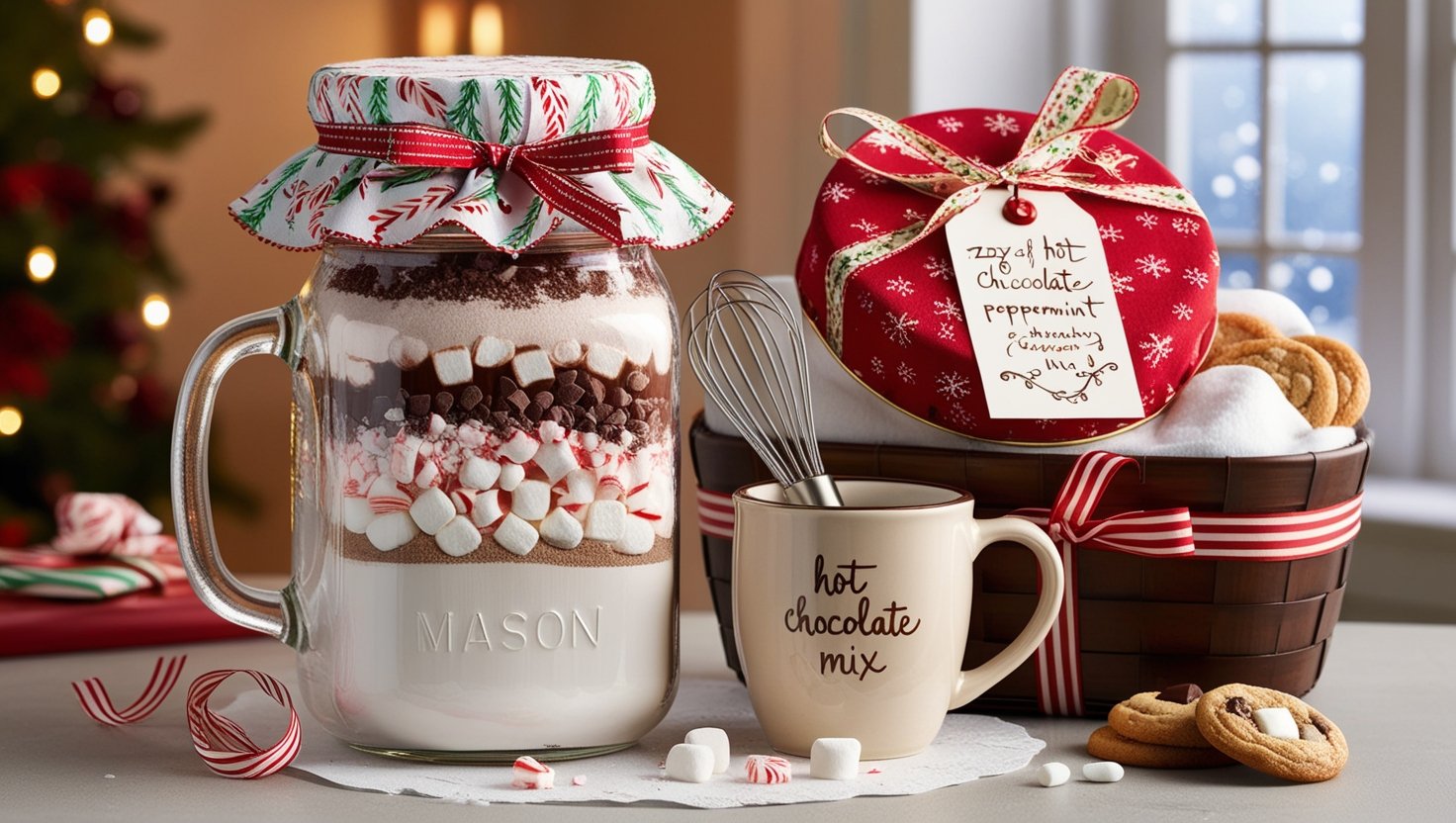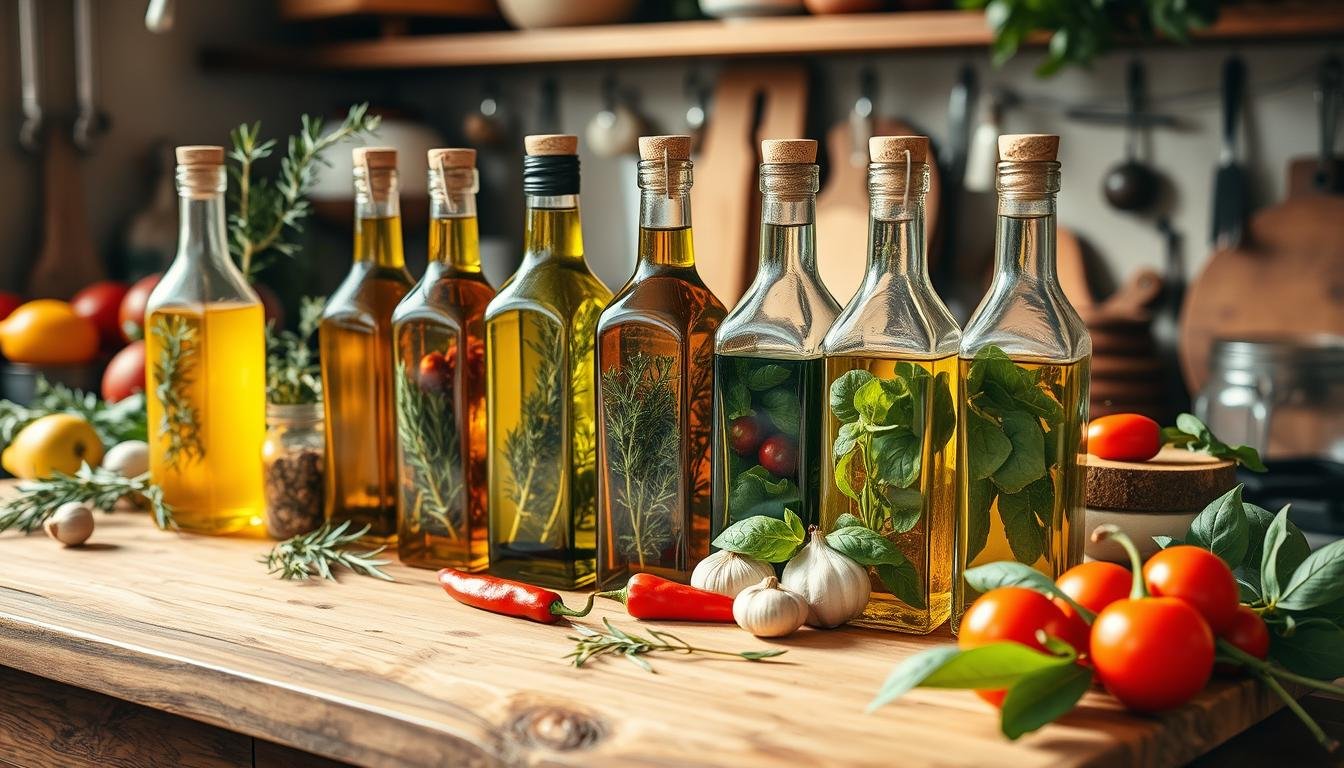
Homemade Infused Cooking Oils: Your Kitchen Guide
The smell of fresh olive oil, mixed with herbs, reminds me of my grandmother’s kitchen. As a kid, I loved watching her mix seasonings. She made simple dishes taste amazing. This inspired me to try making infused oils myself.
In this guide, we’ll explore homemade infused oils. You’ll learn how to make your own tasty oils. We’ll cover everything from the basics to using them in your cooking.
We’ll focus on:
- Discover the art of creating your own infused cooking oils at home
- Explore the science behind oil infusion and the benefits of homemade blends
- Learn about the essential equipment needed to craft your own infused oils
- Understand the best base oils and popular herbs and spices for infusion
- Uncover safety guidelines and storage tips to ensure your infused oils are perfectly preserved
- Unlock creative ways to use your homemade infused oils in cooking, dressings, and more
- Discover how to avoid common mistakes when making infused oils
Understanding the Art of Oil Infusion
Exploring the world of herb-infused oils is a true adventure. It’s all about the art of oil infusion. This process lets you bring out the flavors of herbs and spices.
Basic Principles of Flavor Extraction
The art of oil infusion is simple yet powerful. It extracts the essential oils from herbs and spices. By mixing these with a base oil, like extra virgin olive oil, the flavors blend into the oil.
Benefits of Making Your Own Infusions
- Unparalleled flavor customization to suit your personal taste preferences
- Control over the quality and freshness of the ingredients used
- Ability to create unique, one-of-a-kind specialty oils for cooking and beyond
- Cost savings compared to purchasing pre-made infused oils
- Satisfaction of DIY culinary creativity
Chemistry Behind Oil Infusion
The oil infusion process is full of chemistry. When herbs and spices mix with base oil, their essential oils blend in. This happens because molecules seek balance and dissolve in the oil.
The time and temperature of infusion affect the flavors. By adjusting these, you can make a variety of oils. This lets you match your cooking needs perfectly.
Essential Equipment for Creating Infused Oils
Making your own artisanal oils at home is fun and rewarding. But, you need the right tools and equipment. Here are the essential items for a successful and safe infusion process:
- High-quality glass bottles or jars with airtight lids to store your infused olive oil creations
- Fine-mesh strainers or cheesecloth to filter the infused oil and remove any solid particles or herbs
- A reliable digital thermometer to monitor the temperature during the infusion process
- Chopsticks, skewers, or other long, clean utensils to stir and gently agitate the oil mixture
- A clean, dedicated workspace to prepare your olive oil infusions
It’s important to keep everything clean and sanitized. This prevents harmful bacteria and keeps your homemade gourmet oils safe.
“The right tools can make all the difference in creating flavorful, well-crafted artisanal oils that elevate your cooking to new heights.”
Best Base Oils for Infusion
Choosing the right base oil is key to making your own bespoke oils. You can pick from rich extra virgin olive oil to neutral culinary oils that highlight the infused flavors. There’s a lot to try out.
Extra Virgin Olive Oil Properties
Many people choose extra virgin olive oil for infused cooking oils. It has a strong, fruity taste and is good for your health. But, its bold flavor might hide the taste of other ingredients.
Neutral Oils for Infusing
- Grapeseed oil: It has a light, neutral taste, making it great for showing off infused herbs and spices.
- Sunflower oil: Another good choice, sunflower oil lets the flavors of your infused cooking oils stand out.
Specialty Oil Options
Try using specialty oils like avocado, walnut, or sesame oil for a unique taste. These oils can add special notes to your bespoke oils.
| Oil Type | Flavor Profile | Best Uses |
|---|---|---|
| Extra Virgin Olive Oil | Robust, fruity | Mediterranean-inspired infusions |
| Grapeseed Oil | Light, neutral | Versatile base for various infusions |
| Avocado Oil | Creamy, nutty | Savory, herb-based infusions |
Try different culinary oils to find the best one for your taste. This will make your homemade infused cooking oils even better.
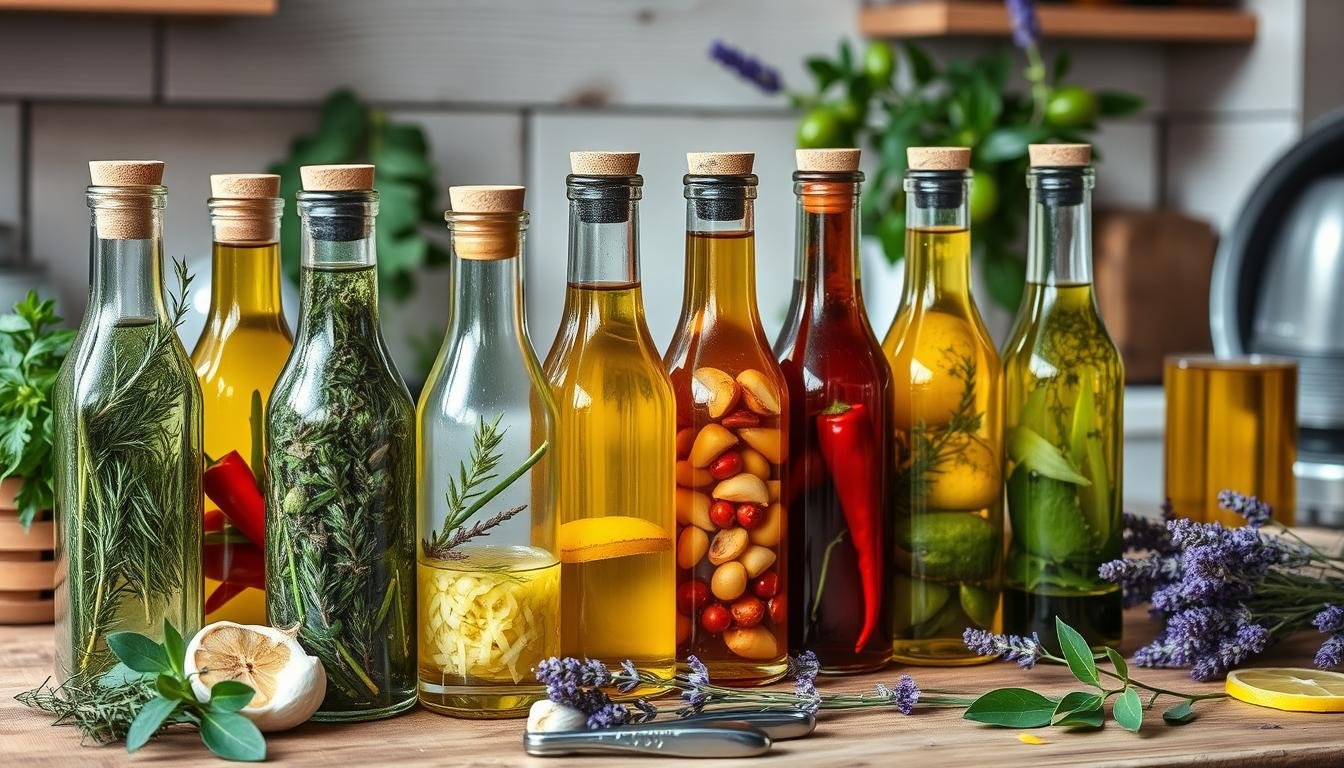
Popular Herbs and Spices for Infused Cooking Oils
Take your cooking to the next level with herb-infused oils. From rosemary’s earthy charm to citrus peel’s zesty kick, there’s a world of flavors waiting for you. Whether you’re making herb-infused oils or exploring new tastes, this guide has the best herbs and spices for you.
Discover how to bring out the best flavors in your kitchen. Turn it into a gourmet paradise with these amazing ingredients:
- Fragrant Basil: Enjoy the sweet, peppery taste of fresh basil in your oils. It’s perfect for dishes inspired by the Mediterranean.
- Earthy Rosemary: Rosemary’s woodsy, pine-like scent is great in oils. It makes roasted veggies and meats taste amazing.
- Zesty Citrus Peel: Add a burst of orange, lemon, or lime zest to your oils. It’s great for salad dressings and marinades.
- Warm Spices: Try cinnamon, cloves, or star anise for oils with deep flavors. They’re perfect for baking and sautéing.
- Peppery Peppercorns: Spice up your oils with black, white, or pink peppercorns. They add a bold, spicy flavor.
There’s no end to the flavors you can create with infused oils. Mix different herbs and spices to find your unique blends. This will take your cooking to new heights.
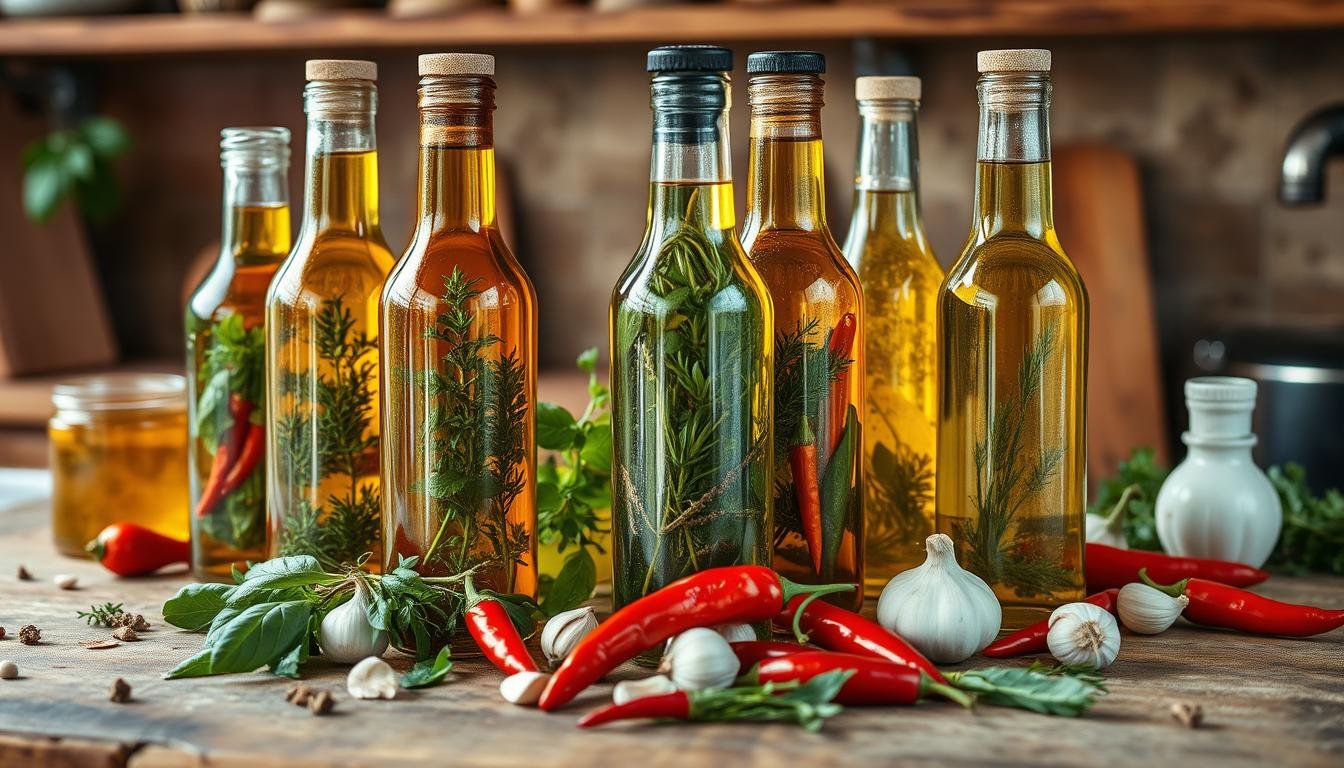
| Herb or Spice | Flavor Profile | Suggested Oil Pairings |
|---|---|---|
| Basil | Sweet, peppery | Olive oil, grapeseed oil |
| Rosemary | Earthy, slightly pine-like | Olive oil, avocado oil |
| Citrus Peel | Bright, zesty | Grapeseed oil, sunflower oil |
| Cinnamon | Warm, sweet | Coconut oil, almond oil |
| Black Peppercorns | Bold, pungent | Olive oil, sesame oil |
“Infused oils are the secret weapons of the culinary world, transforming even the simplest dishes into extraordinary gastronomic experiences.”
Safety Guidelines and Food Preservation
When making your own infused cooking oils, keeping food safe is key. A big worry is botulism, a serious food poisoning caused by bacteria. By sticking to safety rules, you can make sure your gourmet oils and artisanal oils are safe to eat.
Preventing Botulism Risk
To lower botulism risk, follow strict safety steps. Make sure all your tools and surfaces are clean and sterilized. Don’t use old or improperly stored ingredients. Also, keep your infused oils cold to stop harmful bacteria from growing.
Storage Requirements
- Keep your infused oils in tight containers, like clean glass jars or bottles.
- Keep the fridge at a steady cold temperature, below 40°F (4°C).
- Make sure the oils are fully covered in the container, with no air pockets.
- Mark each batch with the date made and what’s inside for easy tracking.
Shelf Life Guidelines
| Oil Type | Shelf Life (Refrigerated) |
|---|---|
| Olive Oil Infusions | 2-3 months |
| Neutral Oil Infusions | 1-2 months |
| Specialty Oil Infusions | 3-4 months |
By sticking to these safety tips and storage methods, you can enjoy your homemade infused cooking oils safely. They’ll stay flavorful for your cooking.
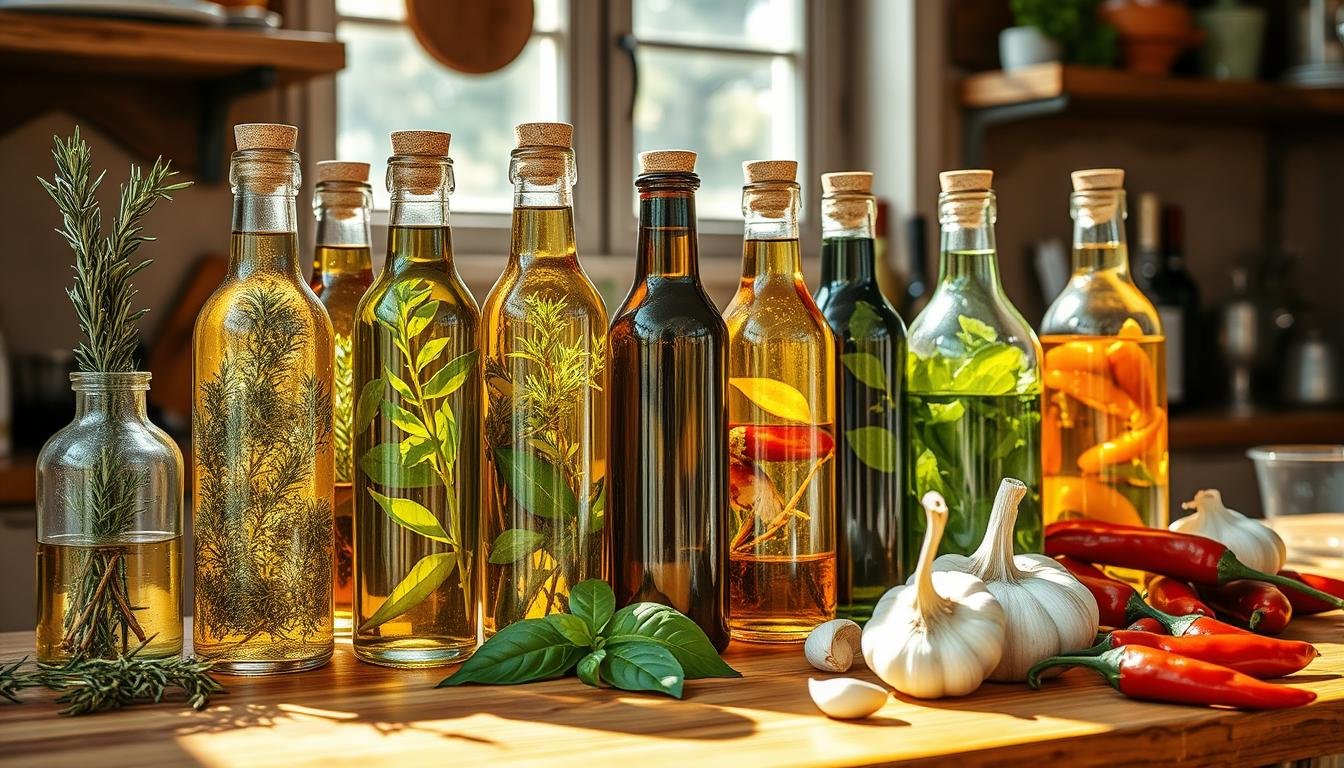
Step-by-Step Infusion Methods
Making your own olive oil infusions and specialty cooking oils at home is fun and tasty. You can use cold infusion, hot infusion, or sous vide. Just follow a few easy steps to make safe and tasty bespoke oils.
Cold Infusion
The cold infusion method is great for delicate herbs and spices. Place your ingredients in a clean, airtight container. Cover them with good oil and let it sit at room temperature for 1-2 weeks. Shake it sometimes. Then, strain the oil through a fine mesh sieve or cheesecloth before bottling.
Hot Infusion
The hot method is faster. It involves heating the oil and ingredients together gently. Use low heat on the stove or in a slow cooker for 2-4 hours. Don’t let it boil. Strain and bottle the oil once it cools down.
Sous Vide Infusion
- The sous vide method gives you precise temperature control. Seal the oil and ingredients in a vacuum-sealed bag. Then, put it in a water bath at 140-180°F.
- Let it steep for 2-4 hours. Then, strain and bottle the oil.
Choose the method you like best. Always follow food safety rules. Store your homemade olive oil infusions and specialty cooking oils well. This way, you can enjoy their great flavors for weeks.
Creating Specialty Gourmet Oil Blends
Take your cooking to new heights by making your own gourmet oils and flavored oils. Discover the endless flavors from different regions. Mix and match to add depth and complexity to your dishes.
Mediterranean Herb Combinations
Get the Mediterranean vibe with oils infused with basil, rosemary, thyme, and oregano. These culinary oils are great for salad dressings, marinades, and veggies. Play with the herb amounts to get your ideal flavor mix.
Asian-Inspired Infusions
Introduce Asian flavors to your kitchen with gourmet oil blends. Use lemongrass, ginger, garlic, and chili peppers. These oils can spice up stir-fries, sauces, and even baked goods.
Spicy Oil Variations
For a spicy kick, mix neutral oils with chili peppers like jalapeño, habanero, or chipotle. These flavored oils add zest to marinades, dressings, and more. They can also make simple foods like bread or popcorn taste amazing.
Have fun experimenting and let your imagination run wild with gourmet oil creations. The fun and tasty results are limitless!
Common Mistakes to Avoid When Making Infused Oils
Making infused cooking oils, herb-infused oils, and aromatic oils at home is fun. But, there are a few mistakes to avoid for safe and tasty oils. Let’s look at these mistakes and how to avoid them for great homemade infused oils.
Overinfusing: A Bitter Mistake
One big mistake is infusing too long, making the oil bitter. Watch the time and taste the oil often. This helps get the right flavor.
Wet Ingredients: A Recipe for Disaster
Using wet ingredients like fresh herbs can lead to spoilage. Make sure your ingredients are dry before adding them to the oil.
Improper Storage: Compromising Freshness
Bad storage can ruin your infused oils. Keep them in airtight containers in a cool, dark spot. This keeps them fresh and flavorful.
- Avoid overexposing ingredients to prevent bitterness
- Use only dry, moisture-free ingredients to prevent bacterial growth
- Store infused oils in airtight containers in a cool, dark place
By avoiding these mistakes, you’ll make delicious, safe, and lasting infused cooking oils, herb-infused oils, and aromatic oils at home.
Creative Ways to Use Your Homemade Oils
Discover the many uses of your homemade specialty cooking oils. They can make simple meals into gourmet dishes. Use them in stir-fries, dressings, and marinades to add flavor.
Cooking Applications
Drizzle your infused oils over roasted veggies, grilled meats, or pasta. They add a burst of flavor. Try them in baking for unique tastes in breads, cakes, or cookies.
Use these oils for sautéing, pan-frying, or as a finishing touch. They bring a special flavor to your dishes.
Dressing and Marinades
Whisk your homemade oils into vinaigrettes, pesto, or dressings. This creates complex flavors. Marinate meats, seafood, or tofu in these oils before cooking.
This tenderizes and infuses them with your desired taste. Use them to enhance salads, grain bowls, and more.
Gift-Giving Ideas
Bottle your infused oils in stylish containers for gifts. Pair them with rustic bread, artisanal cheese, or gourmet seasonings. This makes a delightful gift basket.
Your loved ones will love the personal touch. They get to try new flavors in their kitchens.


